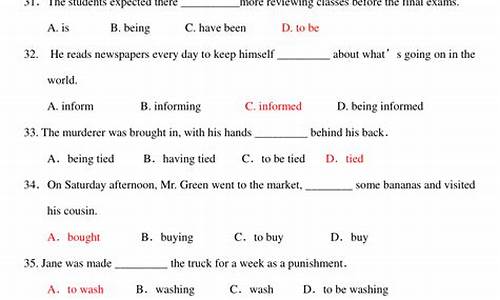您现在的位置是: 首页 > 热门专业 热门专业
非谓语动词高考题2021四川绵阳_非谓语动词高考题
tamoadmin 2024-05-20 人已围观
简介1.Do you consider it any good ______again?A to try B.try C.trying. D for you to try 2.Do you think it any good ___with him again? 据说选to talk.第一题 选C。 D为什么不可以请问 这两句不都是it 作形式宾语吗?不是I consider/ think it is

1.Do you consider it any good ______again?
A to try B.try C.trying. D for you to try
2.Do you think it any good ___with him again?
据说选to talk.
第一题 选C。 D为什么不可以
请问 这两句不都是it 作形式宾语吗?不是I consider/ think it is good to....... 这样吗?
请帮忙加以区分谢谢!
答:这个问题问得好!
第一题选C
译:你认为再试有用处吗?
析:本题考查形式宾语和真正宾语。源于形式主语it和真正主语it
我们知道,不定式和动名词都可以作主语。如用形式主语it,真正的主语多为不定式:
句型1:it is +adj. + to do sth. 如:it is important to do sth.
句型2:it is +n. +to do sth. 如:it is good manners to do sth.
只有下面这种情况下才用动名词作真正的主语:
It is no good/ no use doing sth.
可能因为成语:it is no good crying over the spilt milk. 之故。
所以第一题源于:Do you consider that it is any good trying again?
-->Do you consider it any good trying again?
“consider 后面只能跟 动名词作宾语 所以其他选项错”,这样的回答是有问题的。这里的真正宾语用动名词,不是因为consider是一个只能跟动名词作宾语(不能跟不定式作宾语)的单宾动词。 consider doing sth. 中的consider作“考虑”解释。当consider 作“认为”解释时,是复宾动词,后跟形容词、名词作宾语补足语。
如:We consider him (to be/as) honest (/an honest man) 我们认为他是一个诚实的人。
没有规定其宾语一定要用动名词,根据需要,可以是名词,可以是不定式,也可以是动名词。
这里真宾用动名词是因为句型:it is no good doing sth. 如将any good 改成necessary,则应用不定式作真宾。
请看网上的例句:
We consider it necessary to protect animals.
Before entering this site, we consider it necessary to briefly introduce you to our website.
I consider it necessary to brush three times a day.
第二题中的think与consider可以互换,都是“认为”,都是跟复合宾语,宾补都是any good,由
I think (that) it is no good doing sth. 变化而来。所以你的那个据说的答案“to talk”并不符合考试英语,也不符合语言习惯。因为有It is no good/ no use criying over spilt milk. 这个widespread的谚语。
关于第二题的答案,我认为是在多人改编题目的过程中走样了的结果。
可能原题句是:
Do you think it good ___with him again?
A to talk B talking C to talking D having talked
答案是A 没错,因为这里的good是形容词,it is good to do sth. 与it is no good doing sth.不是一个句型,good的词性也不一样,后者中的good 是名词,与do good to sb. / do sb. good中的good词性相同,是抽象不可数名词,意为“好处”,可以被限定词no, any修饰。
有人将这一题根据“语感”,在good前加了一个any, 从而改变了句型。但答案没有改。
附:从一道高考题看 consider 的用法
动词consider既可作“考虑”讲, 又可作“看作”讲, 二者有什么区别呢? 让我们走近consider, 看看它有哪些用法吧。
93 NMET试题中的一道单项选择题是:
Charles Babbage is generally considered ______ the first computer.
A. to invent
B. inventing
C. to have invented
D. having invented
此题考查的就是consider的用法。让我们对consider的用法作一归纳, 然后, 再做答案。
一、consider意为“考虑, 细想”时, 其后可跟:
1. 名词或代词:
We must consider the matter from different standpoints.
我们应当从各个角度来考虑一下这件事。
We must consider it very carefully. 我们应仔细地考虑它。
2. 从句:
We must consider what's to be done. 我们必须考虑该怎么办。
He considered how he should answer. 他考虑应当怎样回答。
3. “疑问词+不定式”:
Have you considered how to get there? 你是否考虑过如何到那里?
We have to consider what material to use first. 我们先得考虑用什么材料。
注意: consider作“考虑”解时, 不能直接接不定式。
4. 动名词:
He considered going to see them in person. 他考虑亲自去看望他们。
He is considering changing his job. 他在考虑调换一下工作。
5. 介词over或单独用:
He said they had considered over it. 他说他们已经考虑过了。
Let me consider. 让我考虑一下。
二、consider意为“认为, 以为, 把……看作”, 其后可跟:
1. 从句:
We consider that a friend in need is a friend indeed.
我们认为患难之友才是真正的朋友。
2. 名词的复合结构(即名词作宾语补足语):
We consider Beijing the heart of our country.
我们认为北京是我国的心脏。
3. 带形容词的复合结构:
They considered me too young to do the work.
他们认为我太年轻, 干不了这项工作。
4. 带不定式的复合结构:
We consider only such methods to be correct.
我们认为只有这样的方法才是正确的。
注意: 不定式后主要是be, 间或为其它动词(多为完成式)。
We all considered him to have stolen Tom's wallet.
我们都以为是他偷了汤姆的钱包。
5. 带介词短语的复合结构:
We always consider these people as our true comrades.
我们一向认为这些人是我们真正的同志。
They always consider themselves in the right. 他们总认为自己对。
6. 带“it形式宾语+形容词+真正宾语(动词不定式、从句等)”:
We consider it our duty to help her. 我们认为帮助她是我们的职责。
I consider it a great pleasure that I can work with you.
我觉得能和你在一起工作是极大的快乐。
注意: consider作“认为”解时, 一般不接动名词。
综上所述, 我们可以看出前文所提的93年的那道高考题考查的是consider作“认为”解时的用法, 题干是被动式, 改为主动式为:
We generally consider Charles Babbage ______ the first computer. 不难看出, 这一句子的基本结构为: 主语+谓语+复合宾语(名词+动词不定式), 答案应选动词不定式。因“发明”这一动作已经发生, 故应选to have invented, 即C。
练习: I. 选择填空。
1. They have been considering ______ the problem.
a. to work out
b. work out
c. working out
d. worked out
2. I consider Tom ______ the finest basketball player today.
a. to be
b. being
c. was
d. be
3. I don't know ______ .
a. whether they will consider visiting the Summer Palace
b. whether will they consider to visit the Summer Palace
c. whether they will consider to visit the Summer Palace
d. whether they will consider visit the Summer Palace
4. Our monitor ______ to be an honest man.
a. considers
b. is considering
c. was considered
d. has considered
II. 根据第一句完成第二句, 每空填一词, 使句意不变。
1. He was considering repairing the watch.
He was considering ______ ______ ______ the watch.
2. We consider Lu Xun one of the greatest writers in China.
Lu Xun ______ ______ one of the greatest writers in China.
3. We considered that it was necessary to do so.
We considered ______ ______ to do so.
4. I consider the report to be wrong.
I consider the report ______ .
Key: I. 1. c 2. a 3. a 4. c
II. 1. how to repair 2. is considered 3. it necessary 4. wrong
高考英语语法专题讲解-主谓一致
★着重讲解混搭情况,均遵守以下原则:
1. 意义一致原则
主语后跟有以下引起的短语:谓语动词仍与短语前的主语的形式保持一致。
1.1 (together) with: Alice (together) with her parents often goes to the park on Sundays.
1.2 except/but: Every picture except/ but these two has been sold.
Nobody but Mary and I was in the classroom at that time.
1.3 no less than: His sister, no less than you, is wrong.
1.4 rather than: The father, rather than the brothers, is responsible for the accident.
1.5 perhaps : Peter, perhaps John, is playing with the little dog.
1.6 like: He, like you and Xiao Liu is very diligent.
1.7 including/ besides/ as well as
2. 就近原则
2.1 主语由以下连词连接:谓语动词与后一个主语一致:
2.2.1(Either)…or…: Either you or I am going to the movies.
2.2.2 Neither…nor…
2.2.3 Whether…or…
2.2.4 Not only…but (also)
2.2.5 Not…but…
2.2 there be 句型: be 动词与后面第一个名词一致
E.g. There is an apple, two bananas and some oranges on the plates.
2.3副词here, there, now, then, up, down, in, out, away, such连接的全部倒装结构中:谓语动词由动词后面的主语决定
On the wall hang two maps. 墙上挂着两张地图。
On the wall hangs a world of map. 墙上挂着一张世界地图。
Such is the result. 结果就是这样。
Such are the results. 这就是结果
3. 整体原则
3.1 并列主语如果指的是同一个人、同一事物或同一概念时,谓语动词用单数,and后面的名词没有冠词:
The writer and worker is coming to our school tomorrow.
(一个人)
The writer and the worker are coming to our school tomorrow.
(两个人)
Bread and butter is their daily food.
3.2表示时间、距离、价格、度量衡等的复数名词或短语作为一个整体看待时,谓语动词常用单数形式:
E.g. Three years is not a long time.
Ten dollars is what he needs.
Five hundred miles is a long distance.
3.3复数形式的专有名词作为整体看待(人名、地点、国家、组织、书籍、报刊等),动词用单数形式:
E.g. The United Nations has passed a resolution(决议)。
“The Arabian Nights”(《天方夜谭》)is an interesting book.
3.4集合名词people, police ,cattle作主语,谓语动词用复数形式:
E.g. The police are searching for him.
The cattle are grassing (吃草)。
4. 谓单原则
4.1 and连接的并列单数名词前如有each, every, no修饰时,谓语动词要用单数形式。
E.g. Every boy and girl has been invited to the party.
No teacher and no student is absent today.
Many a student is busy with their lessons.
4.2 用many a, more than one 修饰名词时,谓语动词要用单数形式。
E.g. More than one person has made the suggestion.
Many a rough man has been civilized by his wife.
4.3 Each, Either, One, Another, The other, Neither作主语时,谓语动词用单数形式:
E.g. Each takes a cup of tea.
Either is correct.
4.4 由every, some, any, no构成的合成代词作主语时,谓语动词用单数形式:
E.g. Nothing is to be done.
4.5 means, politics, physics, plastics作主语时,谓语动词用单数形式.
5. 具体情况原则
5.1 all, few, more, most, some, any, none, half, the rest等作主语时,既可表示复数意义,也可表示单数意义,谓语动词要根据实际情况而定:
All of the apple is rotten. 整个苹果都烂了。
不可数-> 谓单
All of the apples are rotten. 所有的苹果都烂了。
可数-> 谓复
Most of the wood was used to make furniture.
不可数-> 谓单
Most of the people are from England.
可数-> 谓复
5.2 the + 形容词(或分词)作主语时,常指一类人,谓语动词用复数形式。如指的是抽象概念,谓语动词则用单数形式:
5.3 population当人口讲时,谓语动词用单数形式;当人们讲时,谓语动词用复数:
5.4 the number of + 名词复数,是表示“…的数字”,作主语时,谓语动词用单数形式;
a (large / great) number of + 名词复数,表示许多,作主语时;谓语动词用复数形式:
5.5 有些集体名词如family, team, group, class, audience, government等作主语时,如看作是一个整体,谓语动词则用单数形式;如强调各个成员时,谓语动词要用复数形式:
6. 先行词原则
关系代词who, that, which等在定语从句中作主语时,其谓语动词的数应与句中先行词的数一致。









